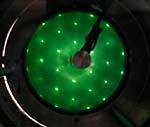We are interested in the fundamental physical processes which govern laser-induced chemical reactions at solid surfaces. At metal surfaces the light can promote a reaction by stimulating the electrons in the metal. These electrons can interact with molecules on the surface of the metal to induce chemical reactions. Our goal is to understand the exchange of energy between the metal substrate and the reactant molecules on the surface. A particular challenge is to time-resolve the reaction path, identifying extremely rapid processes which occur while the molecules are in transition states. The tools available are a mass spectrometer and ultrafast-laser pulses to measure reaction products and induce electronic excitations respectively.
It is difficult to identify the transient reactive species in chemical reactions at surfaces. The reactive species itself is believed to have complicated electronic and vibrational modes of excitation which interact strongly with the substrate. What is the nature of the reactive species? How do energetic electrons in the substrate interact with the adsorbate? On what time-scale is energy transferred to the adsorbate? Is it possible to promote one reaction path over another?
We clean a metal surface in ultra-high vacuum and then cover it with a layer of small molecules. We start a chemical reaction with a laser pulse from a regeneratively-amplified Ti-Sapphire laser. The reaction products are measured with a mass spectrometer. We infer the reaction path by studying the reaction yield as a function of the laser pulse duration, central wavelength, and energy per unit area. A 'two-pulse correlation' experiment, in which two laser pulses strike the surface one after another, is used to study the lifetime of the excitations.
 We can study reactions like this by using laser pulses to stimulate electrons in the metal catalyst. These electrons can interact with molecules stuck to the surface of the metal to induce chemical reactions. Our goal is to understand the exchange of energy between the metal substrate and the reactant molecules on the surface.
We can study reactions like this by using laser pulses to stimulate electrons in the metal catalyst. These electrons can interact with molecules stuck to the surface of the metal to induce chemical reactions. Our goal is to understand the exchange of energy between the metal substrate and the reactant molecules on the surface.